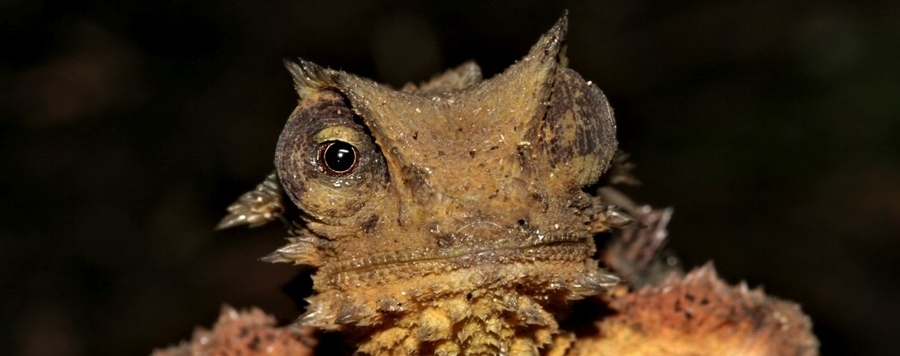"When it comes to chameleons, most people think of the splendid play of colors that is related to intraspecific communication or camouflage", says Dr. Markus Lambertz, zoologist at the Rheinische Friedrich-Wilhelms-Universität Bonn (University of Bonn, Germany) and the Zoologisches Forschungsmuseum Alexander Koenig – Leibniz-Institut für Biodiversität der Tiere (ZFMK, Museum Koenig). Madagascar, however, harbors species that follow a quite different strategy. Many leaf chamelons of the genus Brookesia are small and brownish animals that live cryptic in the understorey. They possess a modified vertebral column that is reminiscent of a saw and supposedly a protective measure against predators. These structres are especially pronounced in the Antsingy leaf chameleon Brookesia perarmata, which also stands out due to its heavily sculptured head and thorny projections along the flanks and legs. "We know this species with its bizarre thorny armor for almost a century, but it remained shrouded in mystery what these structures truly are", says Dr. Frank Glaw from the Zoologische Staatssammlung in Munich.
The scientists decided to collaborate and to tackle the problem. Pia J. Schucht examined the tissue microscopically: "It was quickly obvious that these skin structures have a bony core" explains the doctoral candidate at the University of Bonn. Such ossifications of the dermis are called osteoderms and are for example well-known from crocodiles, in which they form an extensive coverage of the body. But how about our leaf chameleon? The team, meanwhile enlarged for the doctoral candidates Peter T. Rühr from the University of Cologne and Benedekit Geier from the Max-Planck-Institute for Marine Microbiology in Bremen, banked on high-resolution micro-computed-tomography to get an idea of the three-dimensional distribution of the osteoderms in Brookesia perarmata.
As already suggested by the external appearance, the osteoderms occur only localized along the flanks and legs.[ML1] A continuous bony armor is not present. How can this be an effective strategy against predators? Leaf chameleons are preferably preyed on by birds and snakes, both of which swallow their prey in one piece. An extensive protection against bites accordingly would come with no major advantage for them. The thorny osteoderm armor of Brookesia perarmata, on the other hand, unveils itself as an ideal defense strategy particularly against such predators, because it will make swallowing the chameleon extremely unpleasant.
"Osteoderms are not a rarity among reptiles, but they were completely unknown for any chameleon and these ones are furthermore exceptional in their structure", says Dr. Lambertz. Schucht adds: "As diverse as the shape of osteoderms is among reptiles, as diverse appears to be their functional integration". Especially the internal architecture composed of numerous interconnected chambers that are filled with marrow baffles the scientists. It seems obvious that the spiky osteoderms of Brookesia perarmata have a protective function against predators, but it also seems very likely that they play an additional and important role in the animal‘s metabolism. Which exactly remains now to be untangled. Dr. Lambertz: "As with most projects, our new insights immediately raise new questions and it remains extremely exciting to study the diversity of forms in nature".
Download area for photos:
https://gigamove.rz.rwth-Aachen.de/download/id/7wKhDVGgWqn3aA
01A_SchuchtEtAl2020_Brookesia_perarmata_Frank-Glaw.jpg
Brookesia perarmata: A chameleon in a knight‘s armor. Photo: Frank Glaw
01B_SchuchtEtAl2020_Brookesia_perarmata_Frank-Glaw.jpg
Brookesia perarmata: A chameleon in a knight‘s armor. Photo: Frank Glaw
02_SchuchtEtAl2020_Brookesia_perarmata_Skeleton.jpg
Reconstruction of the skeleton of Brookesia perarmata: Numerous spiny osteoderms cover the body and legs. Source: Schucht et al. 2020, Journal of Morphology
03_SchuchtEtAl2020_Brookesia_perarmata_Osteoderm.jpg
Detailed reconstruction of an osteoderm: the external shape is generated by a multicusped bony core displaying numerous cavities. Source: Schucht et al. 2020, Journal of Morphology
04_SchuchtEtAl2020_Brookesia_perarmata_Osteoderm_histo.jpg
Microscopic image of the osteoderm‘s structure: the cavities are filled with marrow. Source: Schucht et al. 2020, Journal of Morphology
Graphics: https://onlinelibrary.wiley.com/doi/full/10.1002/jmor.21135
Publication: Schucht PJ, Rühr PT, Geier B, Glaw F, Lambertz M (2020): Armored with skin and bone: A combined histological and µCT study of the exceptional integument of the Antsingy leaf chameleon Brookesia perarmata (Angel, 1933). – Journal of Morphology (DOI: 10.1002/jmor.21135)
Contact
Dr. Markus Lambertz
Institut für Zoologie
Universität Bonn
Zoologisches Forschungsmuseum Alexander Koenig – Leibniz-Institut für Biodiversität der Tiere
Sektion Herpetologie
Tel. 0228/735491
E-Mail: lambertz [at] uni-bonn.de
Zoological Research Museum Alexander Koenig – Leibniz-Institute for Animal Biodiversity (ZFMK) is an independent research institute. The focus of research is on performing an inventory of the zoological species diversity on earth, on the analysis of changes in biodiversity as a result of environmental factors, and on evolutionary processes at the morphological and molecular levels. ZFMK furthermore explores the context of structure and function of ecological systems, advanced scientific methods, and the study of the history of science. The permanent exhibition “Our blue planet – the living network” offers a genuine nature experience based on naturalistic ecosystem displays.
The Leibniz Association combines 96 independent research institutes. Their focus ranges from the natural, engineering, and environmental sciences to the humanities and the business, space, and social sciences. The Leibniz institutes focus on relevant social, economic, and ecological issues. They perform knowledge-oriented and applied research (also among the cross-disciplinary Leibniz research alliances), are or support scientific infrastructures, and offer research-based services.
Universitiy of Bonn: https://www.uni-bonn.de/








